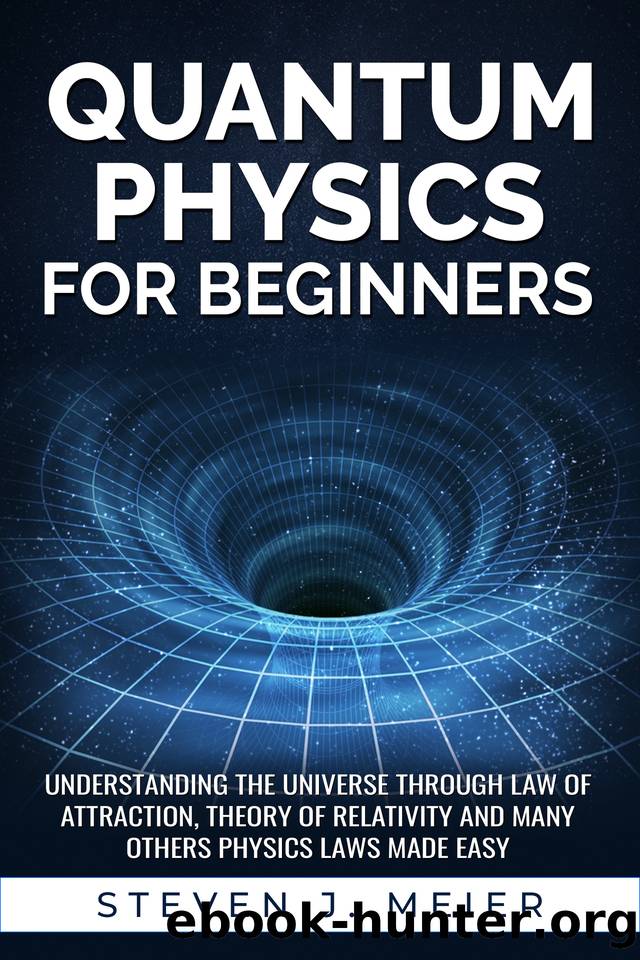Quantum Physics for Beginners: Understanding the Universe through Law of Attraction, Theory of Relativity and many others Physics Laws Made Easy. by J. Meier Steven

Author:J. Meier, Steven [J. Meier, Steven]
Language: eng
Format: epub
Published: 2020-08-01T00:00:00+00:00
THOMAS YOUNG'S DOUBLE-SLIT EXPERIMENT
Young's double-slit experiment can be explained by using the wave-particle duality. The emitted light moves as an electromagnetic wave away from its source. Upon encountering a slit, the wave passes through the slit and divides into two overlapping wave fonts. At the moment of impact on the screen, the wave field "collapses" into a single point and becomes a photon.
UNCERTAINTY PRINCIPLE
The Uncertainty Principle also called the Heisenberg Uncertainty Principle or the Indeterminacy Principle, formulated (1927) by the German physicist Werner Heisenberg, states that the position and velocity of an object cannot be determined precisely at the same time, even in theory. In reality, the very definitions of exact position and exact velocity together have no significance in nature.
Ordinary experience doesn't provide a clue to this principle. It is easy to calculate both the position and the velocity of the vehicle since the uncertainties inherent in this theory for ordinary objects are too small to notice. The complete rule stipulates that the product of uncertainty in position and velocity is equal to or greater than a small physical quantity or constant (h/(4π), where h is the Planck constant or approximately 6.6 × 10−34 joules-second). It is only in the case of tiny masses of atoms and subatomic particles that the result of uncertainty becomes important.
Any attempt to calculate precisely the velocity of a subatomic particle, such as an electron, would have an unforeseen effect on it, such that the simultaneous calculation of its position is invalid. This result has little to do with the inadequacy of the measurement devices, the methodology, or the observer; it results from the intimate relation in nature between the particles and the waves in the subatomic dimensional domain.
Each particle has a wave associated with it; each particle has a wavelike nature. The particle is most likely to be found in those places where the waves are greatest or intense. However, the more intense the related wave's undulations, the more ill-defined the wavelength becomes and which in turn defines the momentum of the particle. Thus, a purely localized wave has an indeterminate wavelength; its corresponding particle, though having a certain position, does not have a certain velocity. On the other hand, a particle-wave with a well-defined wavelength is spread out; the corresponding particle, though having a relatively definite velocity, may be almost anywhere. A reasonably precise measurement of one variable entails a relatively significant uncertainty in the calculation of the other.
Alternatively, the idea of uncertainty is expressed in terms of the momentum and position of the particle. The momentum of a particle is equivalent to the product of its mass and velocity. Thus, the product of uncertainty in the momentum and position of the particle is equal to or greater than h/(4π). The principle applies to other related (conjugate) pairs of observables, such as energy and time: the product of uncertainty in the energy measurement and uncertainty in the time interval during which the measurement is made is also equal to or greater than h/(4π).
Download
This site does not store any files on its server. We only index and link to content provided by other sites. Please contact the content providers to delete copyright contents if any and email us, we'll remove relevant links or contents immediately.
The Complete Stick Figure Physics Tutorials by Allen Sarah(7307)
Secrets of Antigravity Propulsion: Tesla, UFOs, and Classified Aerospace Technology by Ph.D. Paul A. Laviolette(5309)
Thing Explainer by Randall Munroe(3877)
The River of Consciousness by Oliver Sacks(3539)
The Order of Time by Carlo Rovelli(3145)
How To by Randall Munroe(3034)
A Brief History of Time by Stephen Hawking(2960)
I Live in the Future & Here's How It Works by Nick Bilton(2935)
The Great Unknown by Marcus du Sautoy(2646)
What If?: Serious Scientific Answers to Absurd Hypothetical Questions by Randall Munroe(2637)
Midnight in Chernobyl by Adam Higginbotham(2483)
Blockchain: Ultimate Step By Step Guide To Understanding Blockchain Technology, Bitcoin Creation, and the future of Money (Novice to Expert) by Keizer Söze(2445)
Networks: An Introduction by Newman Mark(2360)
The Meaning of it All by Richard Feynman(2300)
Easy Electronics by Charles Platt(2281)
The Tao of Physics by Fritjof Capra(2229)
Midnight in Chernobyl: The Untold Story of the World's Greatest Nuclear Disaster by Adam Higginbotham(2177)
When by Daniel H Pink(2082)
Introducing Relativity by Bruce Bassett(2076)
